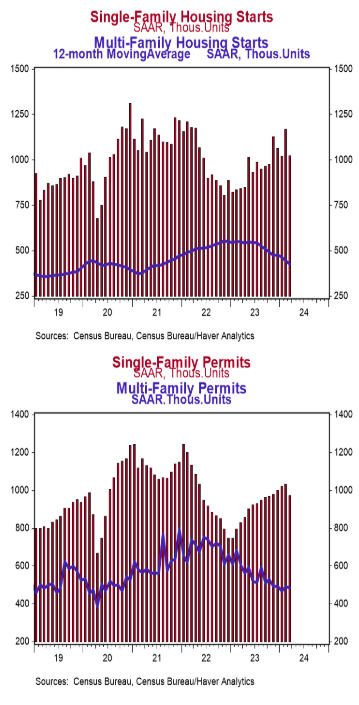- Housing starts declined 14.7% in March to a 1.321 million annual rate, substantially lagging the consensus expected 1.485 million. Starts are down 4.3% versus a year ago.
- The drop in March was due to both single and multi-family starts. In the past year, single-family starts are up 21.2% while multi-unit starts are down 44.3%.
- Starts in March fell in the South, Midwest, and Northeast, but rose in the West.
- New building permits declined 4.3% in March to a 1.458 million annual rate, below the consensus expected 1.510 million. Compared to a year ago, permits for single-family homes are up 17.4% while permits for multi-unit homes are down 20.2%.
Implications: Housing starts posted the largest monthly decline in March since the worst of the COVID pandemic, coming in well short of consensus expectations. However, this follows a surge in starts in February and we do not see March as a sign of persistent weakness ahead in home building. While the data have been very choppy since the Federal Reserve began the current tightening cycle two years ago, it looks like construction activity has bottomed; even with the large drop in March, starts are still above the level from last August. Keep in mind that many owners of existing homes are hesitant to list their homes and give up fixed sub-3% mortgage rates, so many prospective buyers have turned to new builds as their best option. This has boosted demand for developers and should help construction activity going forward. The problem is that with recent inflation reports having come in hotter than expected, the markets – and the Fed itself – seem increasingly doubtful about near-term rate cuts. As a result, long-term interest rates have gone up including mortgage rates. In turn, this could generate a temporary headwind for home sales and housing starts in April. Looking at the details of the report, the slowdown in construction in March was broad-based with three out of four major regions and both single-family and multi-unit starts contributing. Housing permits and completions also took a breather in March, dropping 4.3% and 13.5%, respectively. Another recent theme is the split between single-family and multi-family development. Over the past year, the number of single-family starts is up 21.2% while multi-unit starts are down 44.3%. Permits for single-family homes are up 17.4% while multi-unit home permits are down 20.2%. This huge gap in the data is due to the unprecedented nature of the last four years since COVID began. While we don’t see housing as a major driver of economic growth in the near term, we don’t expect a housing bust like the 2000s on the way, either. Builders built too few homes in the decade before COVID and that shortage should support home prices in the years ahead. In other housing news, the NAHB Housing Index, a measure of homebuilder sentiment, remained at 51 in April. This marks the second month in a row that the index is above 50 since last Summer, signaling that a greater number of builders view conditions as good versus poor.





